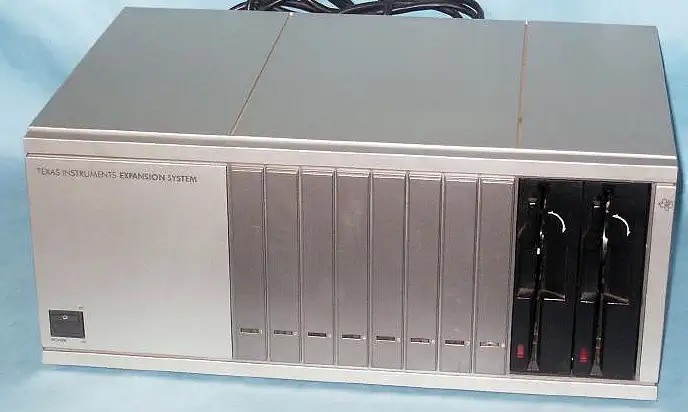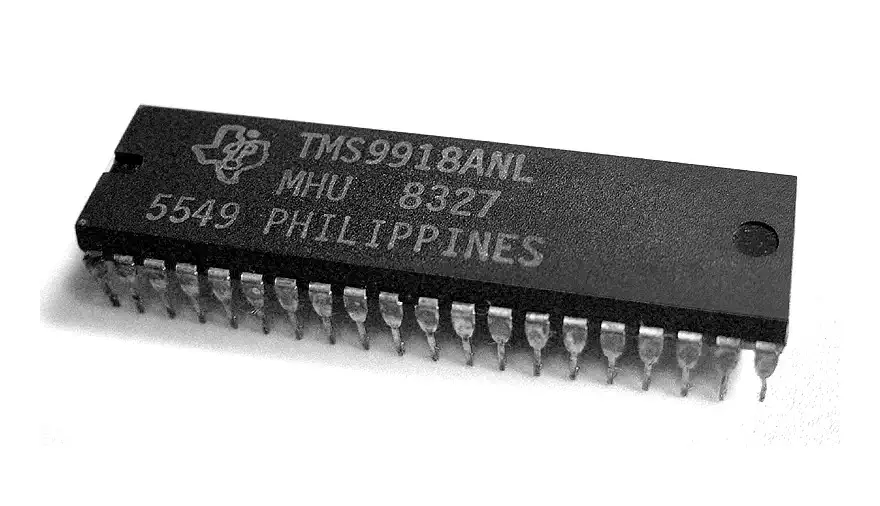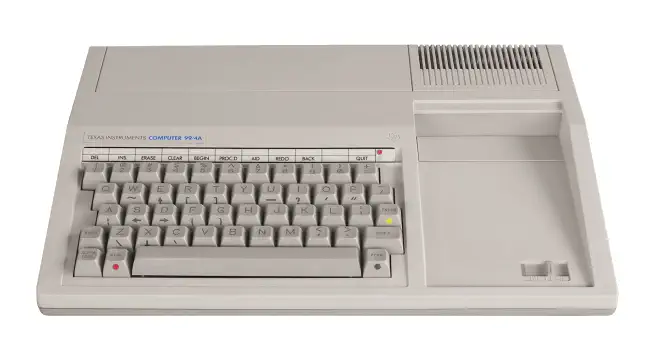Introduction
The TI-99/4A is basically the same system as the TI-99/4 but has a much improved keyboard. The price of the new model dropped by almost half, but still could not compete with the Commodore VIC-20 and Atari computers. By 1983 the 99/4A was selling under $100 and failed to make a profit. Eventually Texas Instruments decided to end production due to lack of sales and support.
Both TI-99/4 models use the 16-bit TMS9900 CPU running at 3 MHz. The TMS9900 is a single-chip implementation of a TI-990 minicomputer. Although a full 16-bit processor, only the system ROM and 256 bytes of scratchpad RAM are available on the 16-bit bus.
In order to build a complete 16-bit system, TI would have had to redesign many of their existing 8-bit support chips. Instead, TI decided to use existing devices for the majority of the system. The result was that only a small portion of the system was 16-bit, and used a second 8-bit computer bus for the rest.
One of the key features of the TMS9900 from the minicomputer design that spawned it was the inclusion of several sets of processor registers. Registers are used to store information that is being actively worked on by a particular program, as opposed to main memory which stores much more data but is slower to access. In a minicomputer setting, the system was typically running a time sharing or multitasking operating system, or being used for real-time computing, both of which benefit from being able to quickly switch among programs. To do this, the TMS9900 stored several sets of registers in main memory and could switch between the sets of sixteen 16-bit registers by changing the single workspace pointer register, thereby allowing very rapid context switching.
The new design put 256 bytes of random access memory (RAM) on the 16-bit bus to store up to eight sets of registers. This area of RAM is known as the "scratchpad memory". As the processor's instructions are all 16-bit as well, the 8 KB internal system read only memory (ROM) was also on the 16-bit side. Only the program counter, status register, and workspace pointer registers are actually implemented on the chip itself.Included on the 8-bit side of the system is the majority of the RAM and almost all of the support chips, especially the video display controller (VDP). All accesses to the VDP system are executed eight bits at a time. The system's RAM is managed by the VDP, which provides access to the CPU only when the CPU is not using the memory. This means that user programs and data has to be read over two machine cycles, essentially reducing speed by half. According to IEEE Spectrum, this negates the performance advantage of a 16-bit processor

TMS9918 Series Video Display Processor (99n8, 99n9, 91n8, 91n9)
The TMS9918 is a series of video display controllers (VDC) manufactured in 1979 by Texas Instruments, also refered to as 'Video Display Processor' (VDP). The TMS9918 and its variants were used in the ColecoVision, CreatiVision, Memotech MTX, MSX, NABU Personal Computer, SG-1000/SC-3000, Spectravideo SV-318, Spectravideo SV-328, Sord M5, Tatung Einstein, Texas Instruments TI-99/4, Casio PV-2000, Coleco Adam, Hanimex Pencil II, and Tomy Tutor.
Key Features:
- 256x192 pattern based color pixels per screen
- 16 different colors
- 8-bit memory mapped CPU interface
- No need for DMA, CPU can access VRAM
- 32 single color Sprites per screen (4 per scanline)
Variants:
- TMS9918A - 60Hz output, NTSC video
- TMS9928A - 60Hz output, YPbPr video
- TMS9929A - 50Hz output, YPbPr video
- TMS9118 - Different RAM than TMS9918A, otherwise identical
- TMS9128 - Different RAM than TMS9928A, otherwise identical
- TMS9129 - Different RAM than TMS9929A, otherwise identical

CPU View - Texas Instruments TMS9900 16-bit
The TMS9900 CPU, developed by Texas Instruments in 1976, is known for being one of the first 16-bit microprocessors available on the market, marking a significant leap forward from the 8-bit processors that were standard at the time. It was originally designed to power Texas Instruments’ own line of minicomputers, but it later found its way into other applications, most notably the TI-99/4A home computer, which was one of the first consumer-grade computers to feature a 16-bit processor.
Some key technical aspects and unique features of the TMS9900:
Architecture
The TMS9900 was based on the TI 990 minicomputer architecture and is fully 16-bit, including a 16-bit data bus and a 16-bit address bus, which allowed it to address up to 64 KB of memory. Its architecture is distinctive because it lacks an internal register set; instead, it relies on external memory-mapped registers, which means the processor operates directly on memory-resident data. This design provided some flexibility but also added overhead, as it depended heavily on memory speed and availability.General Purpose Registers
The TMS9900 had a unique setup where it did not have conventional internal registers. Instead, it used a “workspace†concept, where a block of 16 consecutive memory locations in RAM functioned as general-purpose registers. This workspace could be easily swapped by changing the workspace pointer, which was useful for multitasking and interrupt handling, as it allowed quick context switching by simply switching the pointer to a different set of registers in memory.Performance and Applications
While the TMS9900 was ahead of its time as a 16-bit processor, its reliance on external memory access for registers created bottlenecks. This was one reason why it didn’t see as widespread adoption as other processors of the era. In the TI-99/4A, Texas Instruments paired it with an 8-bit data path to reduce costs, which ultimately limited the TMS9900’s performance and left it underutilized in that system. However, the TMS9900 was also used in some industrial and military applications due to its robust instruction set and multitasking potential, especially before more advanced 16-bit processors like the Intel 8086 became mainstream.
Overall, the TMS9900 is a fascinating processor because it was pioneering in its 16-bit architecture and unique memory-mapped register approach. However, due to cost-cutting limitations and architectural trade-offs, it didn’t reach the widespread usage or influence seen by its contemporaries, but it remains an important milestone in early microprocessor history.
VRAM: 16kB Sound Chip TMS9919, later models used SN94624 Sound 3 voices, 1 white/periodic noise Display Chip TMS9919, later models used SN94624 Display 40x24 text
32x24 16 color text, pattern based
256x192 16 color, 2 color per 8 pix. Best Text 40x24 Best Color 16 colors (2 per 8 pixels) Graphics 256x192 in 16 colors Sprites 1 color, 16x16, 4/scanline, 32 total Original Price $525

